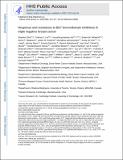Response and resistance to BET bromodomain inhibitors in triple-negative breast cancer
Author(s)
Shu, Shaokun; Lin, Charles Y.; He, Housheng Hansen; Witwicki, Robert M.; Tabassum, Doris P.; Roberts, Justin M.; Janiszewska, Michalina; Jin Huh, Sung; Liang, Yi; Ryan, Jeremy; Doherty, Ernest; Mohammed, Hisham; Guo, Hao; Stover, Daniel G.; Ekram, Muhammad B.; Peluffo, Guillermo; Brown, Jonathan; D’Santos, Clive; Krop, Ian E.; Dillon, Deborah; McKeown, Michael; Ott, Christopher; Qi, Jun; Ni, Min; Rao, Prakash K.; Duarte, Melissa; Wu, Shwu-Yuan; Chiang, Cheng-Ming; Anders, Lars; Young, Richard A.; Winer, Eric P.; Letai, Antony; Barry, William T.; Carroll, Jason S.; Long, Henry W.; Brown, Myles; Liu, X. Shirley; Meyer, Clifford A.; Polyak, Kornelia; Bradner, James; ... Show more Show less
DownloadYoung_Response and resistance.pdf (3.825Mb)
PUBLISHER_POLICY
Publisher Policy
Article is made available in accordance with the publisher's policy and may be subject to US copyright law. Please refer to the publisher's site for terms of use.
Terms of use
Metadata
Show full item recordAbstract
Triple-negative breast cancer (TNBC) is a heterogeneous and clinically aggressive disease for which there is no targeted therapy. BET bromodomain inhibitors, which have shown efficacy in several models of cancer have not been evaluated in TNBC. These inhibitors displace BET bromodomain proteins such as BRD4 from chromatin by competing with their acetyl-lysine recognition modules, leading to inhibition of oncogenic transcriptional programs. Here we report the preferential sensitivity of TNBCs to BET bromodomain inhibition in vitro and in vivo, establishing a rationale for clinical investigation and further motivation to understand mechanisms of resistance. In paired cell lines selected for acquired resistance to BET inhibition from previously sensitive TNBCs, we failed to identify gatekeeper mutations, new driver events or drug pump activation. BET-resistant TNBC cells remain dependent on wild-type BRD4, which supports transcription and cell proliferation in a bromodomain-independent manner. Proteomic studies of resistant TNBC identify strong association with MED1 and hyper-phosphorylation of BRD4 attributable to decreased activity of PP2A, identified here as a principal BRD4 serine phosphatase. Together, these studies provide a rationale for BET inhibition in TNBC and present mechanism-based combination strategies to anticipate clinical drug resistance.
Date issued
2016-01Department
Broad Institute of MIT and HarvardJournal
Nature
Publisher
Nature Publishing Group
Citation
Shu, Shaokun; Lin, Charles Y.; He, Housheng Hansen; Witwicki, Robert M.; Tabassum, Doris P.; Roberts, Justin M.; Janiszewska, Michalina, et al. “Response and Resistance to BET Bromodomain Inhibitors in Triple-Negative Breast Cancer.” Nature 529, no. 7586 (January 2016): 413–417. © 2016 Macmillan Publishers Limited, part of Springer Nature
Version: Author's final manuscript
ISSN
0028-0836
1476-4687